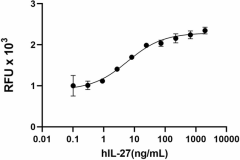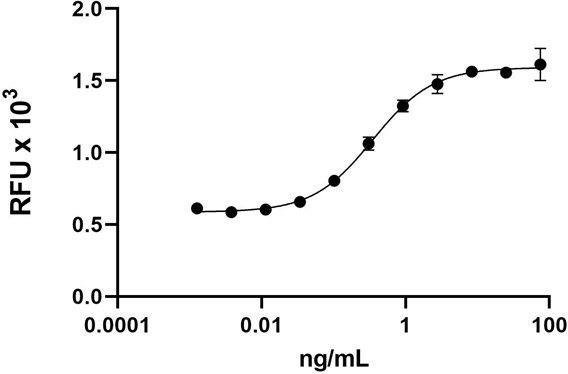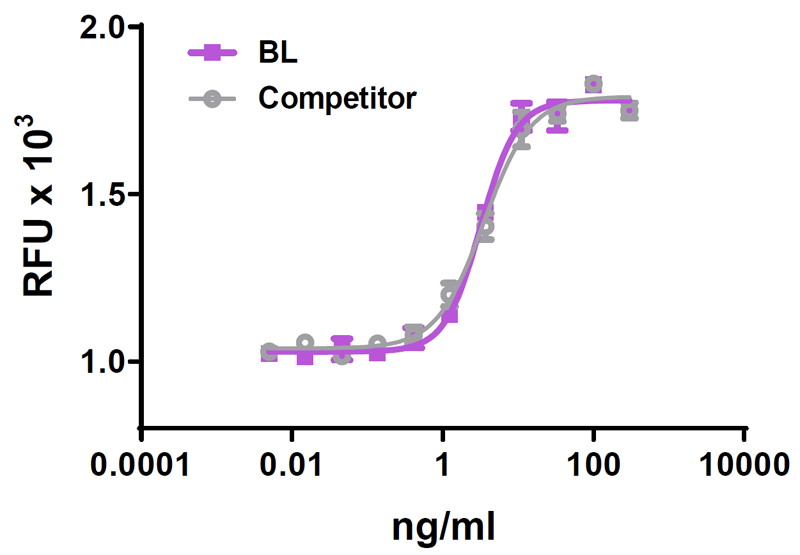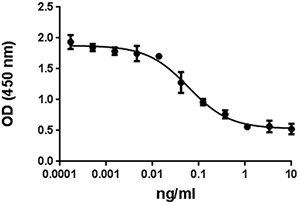- Regulatory Status
- RUO
- Other Names
- IL-27 (28K subunit), IL-27 (EBI3 subunit)
- Ave. Rating
- Submit a Review
- Product Citations
- publications

-

Recombinant Human IL-27 induces the proliferation of TF-1 human erythroleukemic cells in a dose-dependent manner. The ED50 for this effect is 1.5 - 9 ng/mL
| Cat # | Size | Price | Quantity Check Availability | Save | ||
|---|---|---|---|---|---|---|
| 589202 | 10 µg | £150 | ||||
| 589204 | 25 µg | £342 | ||||
IL-27 is a heterodimeric cytokine that consists of EBI3, an IL-12p40-related protein, and p28, an IL-12p35-related polypeptide. IL-27 can be allocated to the IL-6/IL-12 superfamily of cytokines which also includes IL-23. This family is defined based on similarities in the structural motifs of the ligands, such as a common four-helix bundle and their receptors, which contain a hematopoietin receptor domain. IL-27 signaling occurs via a receptor complex composed of the signal transducing receptor chains WSX-1 and glycoprotein (gp) 130. Whereas WSX-1 is the IL-27–specific receptor chain, gp130 is the common receptor subunit of IL-6 type cytokines. IL-27 is expressed at sites of inflammation in cytokine-driven autoimmune/inflammatory diseases, such as rheumatoid arthritis, psoriasis, inflammatory bowel disease, and sarcoidosis.
Product DetailsProduct Details
- Source
- Expressed in CHO cells. Human IL-27 consists of two subunits linked via a 4x(GGGS) bridge: EBV-3 induced gene 3 (EBI3) (Accession# NM_005755 Arg21 - Lys229) and p28 (Accession# NM_145659 Phe29 - Pro243) 10 His-tag.
- Molecular Mass
- The total predicted molecular weight is 50 kD. The non-reduced and the DTT-reduced proteins migrate as one band at approximately 60 kD by SDS-PAGE.
- Purity
- >95%, as determined by Coomassie stained SDS-PAGE.
- Formulation
- 0.22 µm filtered protein solution is in 20 mM HEPES, 300 mM NaCl, 2 mM CHAPS, pH 7.2
- Endotoxin Level
- Less than 0.01 ng per µg cytokine as determined by the LAL method.
- Concentration
- 10 and 25 µg sizes are bottled at 100 µg/mL.
- Storage & Handling
- Unopened vial can be stored between 2°C and 8°C for up to 2 weeks, at -20°C for up to six months, or at -70°C or colder until the expiration date. For maximum results, quick spin vial prior to opening. The protein can be aliquoted and stored at -20°C or colder. Stock solutions can also be prepared at 50 - 100 µg/mL in appropriate sterile buffer, carrier protein such as 0.2 - 1% BSA or HSA can be added when preparing the stock solution. Aliquots can be stored between 2°C and 8°C for up to one week and stored at -20°C or colder for up to 3 months. Avoid repeated freeze/thaw cycles.
- Activity
- Recombinant Human IL-27 induces the proliferation of TF-1 human erythroleukemic cells in a dose-dependent manner. The ED50 for this effect is 1.5 - 9 ng/mL
- Application
-
Bioassay
- Application Notes
-
BioLegend carrier-free recombinant proteins provided in liquid format are shipped on blue-ice. Our comparison testing data indicates that when handled and stored as recommended, the liquid format has equal or better stability and shelf-life compared to commercially available lyophilized proteins after reconstitution. Our liquid proteins are verified in-house to maintain activity after shipping on blue ice and are backed by our 100% satisfaction guarantee. If you have any concerns, contact us at tech@biolegend.com.
- Product Citations
-
Antigen Details
- Structure
- Heterodimer
- Distribution
-
Monocytes, macrophages, DC
- Function
- IL-27 triggers rapid clonal expansion of antigen-specific naive human and mouse CD4 T cell. IL-27 promotes the early Th1 differentiation through up-regulation of ICAM-1 and T-bet, and suppresses the differentiation to Th2 and Th17. In addition, IL-27 suppresses the cytokine production by activated CD4+ T cells in vitro, and TNF-α and IL-12 production by macrophages. This suppressive mechanism is considered to be mediated through IL-10. IL-27 plays a dominant function together with TGF-β in generating IL-10-producing anti-inflammatory Tr1 cells. Additionally, IL-27 exerts IFN-like functions in liver cells, and is a negative regulator of human neutrophils function. IL-27 is predominantly produced early after stimulation of APCs by TLR ligands or infectious agents, and it is induced by TNF-α in human macrophages.
- Interaction
- Activated T cells, resting NK cells, resting NKT cells, neutrophils, eosinophils, mast cells, hepatic stellate cells, hepatoma cells, and hepatocytes
- Ligand/Receptor
- IL-27RA (also known as WSX-1 or TCCR) paired with gp130
- Biology Area
- Apoptosis/Tumor Suppressors/Cell Death, Cell Biology, Immunology, Signal Transduction
- Molecular Family
- Cytokines/Chemokines
- Antigen References
-
1. Pflanz S, et al. 2002. Immunity 16:779.
2. Owaki. T, et al. 2005. J. Immunol. 175:2191.
3. Batten M, et al. 2006. Nat. Immunol. 7:929.
4. Villarino VA, et al. 2006. J. Immunol. 176:237.
5. Stumhofer JS, et al. 2007. Nat. Immunol. 8:1363.
6. Awasthi A, et al. 2007. Nat. Immunol. 8:1380.
7. Pot C, et al. 2009. J. Immunol. 183:797.
8. Bender H, et al. 2009. Hepatology 50:585.
9. Kalliolias GD, et al. 2010. J. Immunol. PMID:20971923. - Gene ID
- 246778 View all products for this Gene ID
- UniProt
- View information about IL-27 on UniProt.org
Related FAQs
- Why choose BioLegend recombinant proteins?
-
• Each lot of product is quality-tested for bioactivity as indicated on the data sheet.
• Greater than 95% Purity or higher, tested on every lot of product.
• 100% Satisfaction Guarantee for quality performance, stability, and consistency.
• Ready-to-use liquid format saves time and reduces challenges associated with reconstitution.
• Bulk and customization available. Contact us.
• Learn more about our Recombinant Proteins. - How does the activity of your recombinant proteins compare to competitors?
-
We quality control each and every lot of recombinant protein. Not only do we check its bioactivity, but we also compare it against other commercially available recombinant proteins. We make sure each recombinant protein’s activity is at least as good as or better than the competition’s. In order to provide you with the best possible product, we ensure that our testing process is rigorous and thorough. If you’re curious and eager to make the switch to BioLegend recombinants, contact your sales representative today!
- What is the specific activity or ED50 of my recombinant protein?
-
The specific activity range of the protein is indicated on the product datasheets. Because the exact activity values on a per unit basis can largely fluctuate depending on a number of factors, including the nature of the assay, cell density, age of cells/passage number, culture media used, and end user technique, the specific activity is best defined as a range and we guarantee the specific activity of all our lots will be within the range indicated on the datasheet. Please note this only applies to recombinants labeled for use in bioassays. ELISA standard recombinant proteins are not recommended for bioassay usage as they are not tested for these applications.
- Have your recombinants been tested for stability?
-
Our testing shows that the recombinant proteins are able to withstand room temperature for a week without losing activity. In addition the recombinant proteins were also found to withstand four cycles of freeze and thaw without losing activity.
- Does specific activity of a recombinant protein vary between lots?
-
Specific activity will vary for each lot and for the type of experiment that is done to validate it, but all passed lots will have activity within the established ED50 range for the product and we guarantee that our products will have lot-to-lot consistency. Please conduct an experiment-specific validation to find the optimal ED50 for your system.
- How do you convert activity as an ED50 in ng/ml to a specific activity in Units/mg?
-
Use formula Specific activity (Units/mg) = 10^6/ ED50 (ng/mL)
 Login / Register
Login / Register 














Follow Us